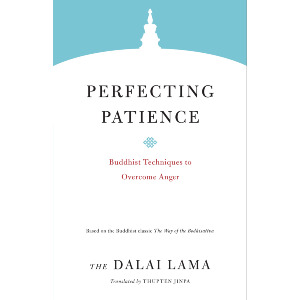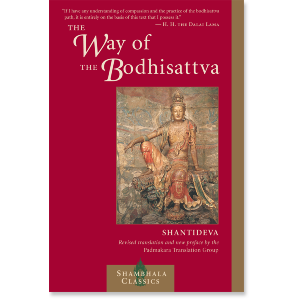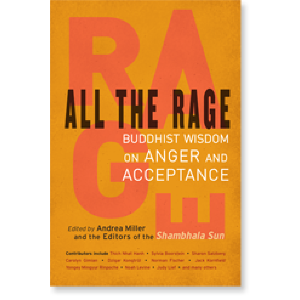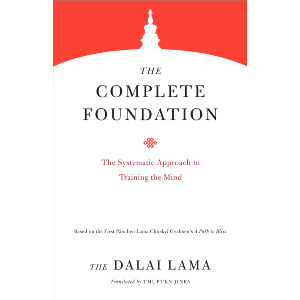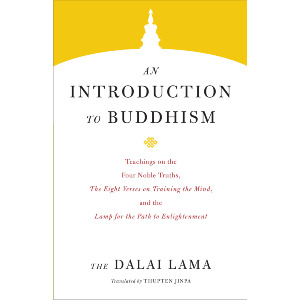Generally speaking, all the major religions of the world emphasize the importance of the practice of love, compassion, and tolerance. This is particularly the case in all the traditions of Buddhism, including the Theravada, Mahayana, and Tantrayana (the esoteric tradition of Buddhism). They all state that compassion and love are the foundation of all the spiritual paths.
In order to enhance one’s development of compassion and cultivate the potential for compassion and love inherent within oneself, what is crucial is to counteract their opposing forces. It is in this context that the practice of patience or tolerance becomes very important, because only through patience is one able to overcome the obstacles to compassion.
When we talk about patience or tolerance, we should understand that there are many degrees, starting from a simple tolerance, such as being able to bear a certain amount of heat and cold, progressing toward the highest level of patience, which is the type of patience and tolerance found in the great practitioners, the Bodhisattvas on the high levels of the Buddhist path. Since patience or tolerance comes from a certain ability to remain firm and steadfast, to not be overwhelmed by the adverse situations or conditions that one faces, one should not see tolerance or patience as a sign of weakness, but rather as a sign of strength coming from a deep ability to remain steadfast and firm. We can generally define patience or tolerance in these terms. We find that even in being able to tolerate a certain degree of physical hardship, like a hot or cold climate, our attitude makes a big difference. If we have the realization that tolerating immediate hardship can have long-term beneficial consequences, we are more likely to be able to tolerate everyday hardships. Similarly, in the case of those on the Bodhisattva levels of the path practicing high levels of tolerance and patience, intelligence also plays a very important role as a complementary factor.
In addition to the value of the practice of tolerance and patience from the Dharma point of view, even in our day-to-day life experiences tolerance and patience have great benefits, such as being able to sustain and maintain our calmness of mind, peace of mind, and presence of mind. So if an individual possesses this capacity of tolerance and patience, then even if the person lives in a very tense environment, one that is frantic and stressful, the person’s calmness and presence of mind will not be disturbed.
The text from which I am teaching in this series of lectures is a Buddhist text and specifically a text of Mahayana Buddhism. Many of the practices outlined in this work are presented from the point of view of a practitioner who is engaged in the Mahayana path of cultivating bodhichitta and living a way of life according to the Bodhisattva principles. However, many of the techniques and methods which are presented are also relevant and applicable to individuals who do not engage in Bodhisattva practices, or who do not subscribe to Buddhism as a personal religion.
This text is called the Bodhisattvacharyavatara in Sanskrit, which is translated as Guide to the Bodhisattva’s Way of Life. When we speak of the activities of a Bodhisattva, there are three levels. The first is the entry into the Bodhisattva path, which principally involves generating bodhichitta, the altruistic aspiration to attain full enlightenment for the benefit of all sentient beings. That is the first level of practice. This is followed by what is known as the actual practice, which consists of the practice of the six perfections. Among the six perfections, which are the main precepts of generating bodhichitta, one is patience or tolerance. The third level of Bodhisattva deeds comprises the activities at the state of Buddhahood, which results from this practice.
In the first chapter of the Guide to the Bodhisattva’s Way of Life, Shantideva talks about the merits and benefits of generating bodhichitta, the altruistic aspiration to attain Buddhahood for the benefit of all sentient beings. He states:
I bow down to the body of him
In whom the sacred precious mind is born.
I seek refuge in that source of joy
Who brings to happiness even those who harm him.
(Guide, I:36)
In this verse, he states that since this altruistic aspiration develops to the infinite capacity of helping all other sentient beings, the person who generates that kind of infinite altruism is truly an object worthy of respect and reverence. Because this infinite altruism is the source of joy and happiness not only for oneself but also for countless other sentient beings, any interaction that other individuals might have with such a person, even a negative one, will leave a very powerful imprint on that individual’s life. Even if one commits a negative act or has a negative relationship, although its immediate consequences may be negative, in the long run the very fact that one had an interaction with such a person will lead to positive consequences and benefit in the future. Such is the power of this infinite altruism.
The true foundation of this infinite altruism is compassion, and because compassion is the root of infinite altruism, Chandrakirti—unlike other authors who at the beginning of their text pay homage to the Buddha or a Bodhisattva or a meditational deity—in his text called the Guide to the Middle Way pays homage to compassion and points out that its importance and its value remain throughout all time. At the beginner’s level, its value cannot be underestimated. While the individual is on the path, the value of compassion and its importance cannot be underestimated. Even at the resultant state of Buddhahood, compassion still retains its importance and value. We find that all major world religions, although they may have different ways of teaching compassion and different ways of explaining why enhancement of a compassionate attitude is important, converge on the single point that compassion is the root. It is crucial.
Compassion and love are the foundation of all the spiritual paths.
Compassion can be roughly defined in terms of a state of mind that is nonviolent and nonharming, or nonaggressive. Because of this there is a danger of confusing compassion with attachment and intimacy.
So we find that there are two types of love or compassion. On the one hand is compassion or love which is based on attachment or which is tinged with attachment. That type of love or compassion and feeling of intimacy is quite partial and biased, and it is based very much on the consideration that the object of one’s affection or attachment is someone who is dear or close to one. On the other hand, genuine compassion is free from such attachment. There the motivation is not so much that this person is my friend, is dear to me or related to me. Rather, genuine compassion is based on the rationale that just as I do, others also have this innate desire to be happy and overcome suffering; just as I do, they have the natural right to fulfill this fundamental aspiration. Based on that recognition of this fundamental equality and commonality, one develops a sense of affinity and closeness, and based on that, one will generate love and compassion. That is genuine compassion.
It is also very clear that one’s level of intelligence or wisdom is a complementary factor that will determine the intensity and the depth of one’s compassion. In Buddhism, there are discussions of three principal types of compassion. One is a compassion which is not complemented by any wisdom factors. A second level of compassion is complemented by insight into the transient nature of sentient beings, their impermanent nature. At the third level of compassion, called nonobjectified compassion, the complementary factor is wisdom or insight into the ultimate nature of reality. At this level, one sees the empty nature of sentient beings, and that insight reinforces one’s compassionate attitude toward sentient beings. Even though this type of genuine compassion and infinite altruism is something that needs to be consciously cultivated and developed, we all possess the basis or potential for such enhancement and such development.
One of my fundamental beliefs is that not only do we inherently possess this potential or basis for compassion, but also the basic or fundamental human nature is gentleness. Not only human beings but all sentient beings have gentleness as their fundamental nature. There are other grounds upon which I base this belief, without having to resort to the doctrine of Buddha-nature. For example, if we look at the pattern of our existence from an early age until our death, we see the way in which we are so fundamentally nurtured by affection, each other’s affection, and how we feel when we are exposed to others’ affection. In addition, when we ourselves have affectionate feelings we see how it naturally affects us from within. Not only that, but also being affectionate and being more wholesome in our behavior and thought seems to be much more suited to the physical structure of our body in terms of its effect on our health and physical well-being, and so on. It must also be noted how the contrary seems to be destructive to health. For these reasons I think that we can infer that our fundamental human nature is one of gentleness. Now if this is the case, then it makes all the more sense to try to live a way of life which would be more in accordance with this basic gentle nature of our being.
However, we do find a lot of conflict and tension not only within our individual mind but also within the family, when we interact with other people, and also at the societal level, the national level, the global level, and so on. How do we account for that?
One of the factors, I think, that contributes to this conflict is our imaginative faculty, or in other words, intelligence. It is also our intelligence which can find ways and means to overcome this conflict. So in using human intelligence to overcome this conflict which is created by human intelligence, the important factor is human compassion. I think if we look at the reality, it is quite clear that the best way to overcome conflict is the spirit of reconciliation, even within oneself. That spirit has very much to do with compassion.
One aspect of compassion is to respect others’ rights and to respect others’ views. That is the basis of reconciliation. I think the rule of the human spirit of reconciliation which is based on compassion is working deep down, whether the person really knows it or not. Therefore, because our basic human nature is gentleness, no matter how much we go through violence and many bad things, ultimately the proper solution is to return to the basic human feeling, that is, human affection. So human affection or compassion is not only a religious matter, but in our day-to-day life it is quite indispensable.
Now with this as a background, if one looks at the practice of tolerance, it is really worthwhile. No matter how difficult, it is worthwhile to do this practice. The first verse of Shantideva’s “Patience” chapter reads:
(1) Whatever wholesome deeds,
Such as venerating the Buddhas and [practicing] generosity,
That have been amassed over a thousand eons,
Will all be destroyed in one moment of anger.
The implication of this first verse is that in order for the individual practitioner to be able to successfully cultivate patience and tolerance, what is required is a very strong enthusiasm, a strong desire, because the stronger one’s enthusiasm the greater the ability to withstand the hardships encountered in the process. Not only that, but one also will be prepared to voluntarily accept hardships that are a necessary part of the path.
I think if we look at the reality, it is quite clear that the best way to overcome conflict is the spirit of reconciliation, even within oneself. That spirit has very much to do with compassion.
The first stage, then, is to generate this strong enthusiasm, and for that what is required is to reflect upon the destructive nature of anger and hatred, as well as the positive effects of patience and tolerance.
In this text, one reads that the generation of anger or hatred, even for a single instant, has the capacity to destroy virtues collected over a thousand eons. Another text, the Entry into the Middle Way by Chandrakirti, states that a single instant of anger or hatred will destroy virtues accumulated over a hundred eons. The difference between these two texts is explained from the point of view of the object of one’s anger or hatred. If the object of one’s anger or hatred is a Bodhisattva on a high level of the path, and the person who is being hateful or angry is not a Bodhisattva, then the amount of virtue which will be destroyed is greater. On the other hand, if a Bodhisattva generates anger toward another Bodhisattva, maybe the virtue destroyed would be less. So it is in this regard that the differences are explained.
However, when we say that virtues accumulated over eons are destroyed by a single instant of anger, we have to identify what sort of virtues are destroyed. Both this text and Entry into the Middle Way agree that it is only the meritorious virtues, not so much the wisdom aspect but rather the method aspect of the path, which are destroyed. In particular, these include virtues accumulated through practicing giving or generosity as well as virtues accumulated on the basis of observing an ethically disciplined way of life. On the other hand, virtues accumulated through the practice of wisdom, such as generating insight into the ultimate nature of reality, and virtues accumulated through meditative practices, wisdom acquired through meditation, remain beyond the scope of destruction by anger and hatred.
Here there is a mention of the word “eons.” A particular Buddhist system of measurement is used here, based on the Abhidharma system, in which “eons” refers to a “great eon,” which is composed of twenty middle-length eons. This is also related to Buddhist cosmology, the theory within which the whole evolutionary process of the universe is explained. For instance, according to Abhidharma cosmology, we divide the time of evolution into four stages—the time of empty space, the time of evolution, the time of abiding, and the time of destruction—and all of these are divided according to this precise system. It may be interesting to compare that with the current cosmological theory based on the big bang theory, in which evolution is explained in terms of fifteen to twenty billion years.
According to this verse, the virtues which are complemented by the factor of wisdom, particularly insight into the ultimate nature of reality (the realization of emptiness), and also any virtues which are based on the realization or attainment of shamatha (calm abiding or single-pointedness of mind) remain beyond the scope of destruction by anger and hatred. Therefore, we see the value of generating shamatha and insight into emptiness.
The second verse reads:
2) There is no evil like hatred,
And no fortitude like patience.
Thus I should strive in various ways
To meditate on patience.
Generally speaking, there are many afflictive emotions such as conceit, arrogance, jealousy, desire, lust, closed-mindedness, and so on, but of all these, hatred or anger is singled out as the greatest evil. This is done for two reasons.
One is that hatred or anger is the greatest stumbling block for a practitioner who is aspiring to enhance his or her bodhichitta—altruistic aspiration and a good heart. Anger or hatred is the greatest obstacle to that.
Second, when hatred and anger are generated they have the capacity to destroy one’s virtue and calmness of mind. It is due to these reasons that hatred is considered to be the greatest evil.
Hatred is one of the six root afflictive emotions according to Buddhist psychology. The Tibetan word for it is zhe dang (Tib. zhe sdang), which can be translated as either “anger” or “hatred” in English. However, I feel that it should be translated as “hatred,” because “anger,” as it is understood in English, can be positive in very special circumstances. These occur when anger is motivated by compassion or when it acts as an impetus or a catalyst for a positive action. In such rare circumstances anger can be positive whereas hatred can never be positive. It is totally negative.
Since hatred is totally negative, it should never be used to translate the Tibetan word zhe dang when it appears in the context of tantra. Sometimes we hear the expression “taking hatred into the path.” This is a mistranslation. In this context, hatred is not theright word; one should use “anger”: “taking anger into the path.” So the Tibetan word can be translated as either “anger” or “hatred,” but “anger” can be positive; therefore, when zhe dang refers to the afflictive emotion it must be translated as “hatred.”
The last two lines of the second verse read:
Thus I should strive in various ways
To meditate on patience.
Since the goal is the enhancement of one’s capacity for tolerance and the practice of patience, what is required is to be able to counteract the forces of anger and hatred, particularly hatred. One should use all sorts of techniques to increase one’s familiarity with patience. These include not only real life situations, but also using one’s imagination to visualize a situation and then see how one will react and respond to it. Again and again one should try to combat hatred and develop one’s capacity for tolerance and patience.
(3) My mind will not experience peace
If it fosters painful thoughts of hatred.
I shall find no joy or happiness;
Unable to sleep, I shall feel unsettled.
This verse outlines the destructive effects of hatred, which are very visible, very obvious and immediate. For example, when a strong or forceful thought of hatred arises, at that very instant it overwhelms one totally and destroys one’s peace and presence of mind. When that hateful thought is harbored inside, it makes one feel tense and uptight, and can cause loss of appetite, leading to loss of sleep, and so forth.
Generally speaking, I believe that the purpose of our existence is to seek happiness and fulfillment. Even from the Buddhist point of view, when we speak of the four factors of happiness, or four factors of fulfillment, the first two are related to the attainment of joy and happiness in worldly terms, leaving aside ultimate religious or spiritual aspirations such as liberation and enlightenment. The first two factors deal with joy and happiness as we understand them conventionally, in worldly terms. In order to more fully experience that level of joy and happiness, the key is one’s state of mind. However, there are various factors that contribute to attaining that level of joy and happiness, which we conventionally also recognize as sources of happiness, such as good physical health, which is considered one of the factors necessary for a happy life. Another factor is the wealth that we accumulate. Conventionally, we regard this as a source of joy and happiness. The third factor is to have friends or companions. We conventionally recognize that in order to enjoy a happy and fulfilled life, we also need a circle of friends we trust and with whom we can relate emotionally.
Related Books
$18.95 - Paperback
$16.95 - Paperback
$17.95 - Paperback
$22.95 - Paperback
$16.95 - Paperback




